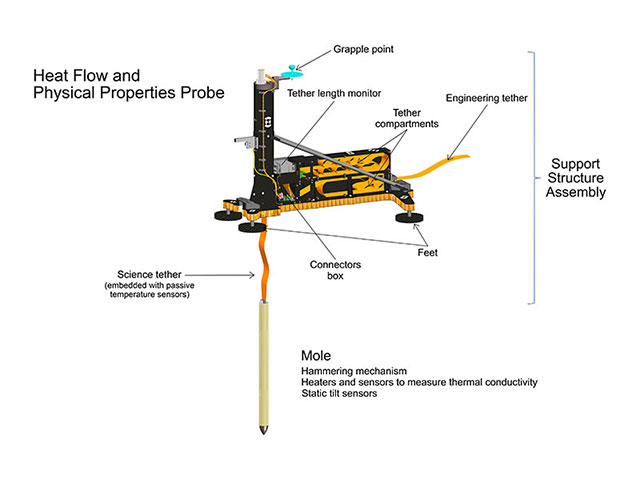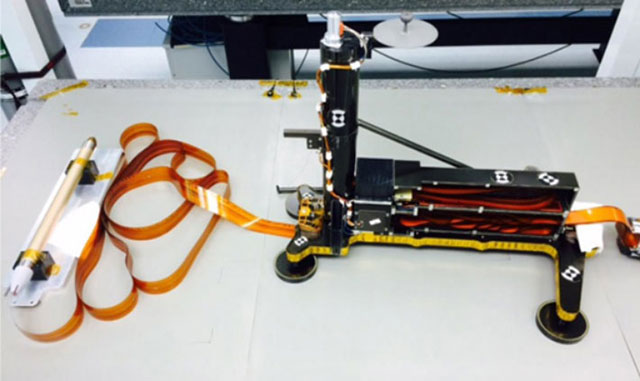Heat Flow and Physical Properties Probe
InSight's Heat Flow and Physical Properties Probe (HP3, pronounced "H-P cubed") will use a self-hammering mechanical mole burrowing to a depth of 10 to 16 feet (3 to 5 meters). Measurements by sensors on the mole and on a science tether from the mole to the surface will yield the first precise determination of the amount of heat escaping from the planet's interior.
Heat flow is a vital sign of a planet. It carries information about the interior heat engine that drives the planet's geology. Heat is the energy that powers planetary evolution, shaping the mountains and canyons of the surface. A planet's interior heat affects how primordial ingredients of planetary formation form layers and how volatile components, such as water molecules, are released to the surface or atmosphere. Determining modern temperature flux will help scientists discriminate between models for how the interior of Mars has evolved over time.
Heat flow also foretells the destiny of a planet: the pace at which its core energy is diminishing.
InSight's heat probe will penetrate more than 15-fold deeper beneath the surface than any previous hardware on Mars. The current record was achieved by the scoop of NASA's Phoenix Mars lander digging to a depth of about 7 inches (18 centimeters), though radar instruments on Mars orbiters have revealed details of features much deeper, down to a few miles or kilometers.
The depth of the heat probe's emplacement will get it away from most effects of daily and seasonal temperature changes at the surface. On Earth, experiments to measure heat flow from the planet's interior must go deeper because water movement in the ground extends the effects of surface-temperature variations, but 10 feet (3 meters) is calculated as deep enough for useful measurement of heat flowing outward from the interior of Mars.
The instrument's mole is expected to use thousands of hammering strokes of a spring-loaded tungsten block, over the course of about 30 days, to reach its full depth. The total number of strokes needed is expected to be between 5,000 and 20,000, depending on characteristics of the ground the device is traveling through, such as how compacted the soil is. The mole is about 1 inch (2.7 centimeters) in diameter and about 16 inches (40 centimeters) long -- about the diameter of a U.S. quarter and the length of a forearm. The exterior is an aluminum cylinder with the downward end tapered to a point, making it the shape of a finishing nail.

Illustration of InSight's HP3 instrument with some key components labeled. Download image
The mole carries sensors and heaters to determine the thermal conductivity of the ground around it. The thermal conductivity experiment measures how long it takes heat released from the surface of the probe to reach temperature sensors at a known distance away. The conductivity information is combined with information from sensors about ground temperature at different depths -- the thermal gradient -- to determine heat flux. The HP3 sensors can measure temperature differences as small as about two one-hundredths of a degree Fahrenheit (about one one-hundredth of a degree Celsius).
The mole also contains the hammering mechanism and tilt sensors. A motor attached to a gearbox slowly compresses and then quickly releases a spring that drives the tungsten hammer against the interior of the mole tip, at a pace of one stroke every 3.6 seconds. The tilt sensors provide information about how much of the mole's motion is net downward penetration and how much is lateral, out of total burrowing motion determined by monitoring the length of science tether pulled into the ground.
The science tether connects the upper end of the mole to the HP3 support structure, which InSight's robotic arm will place directly onto the Martian surface. The support structure remains connected the lander by an engineering tether. Both tethers carry data and electricity. The science tether has 14 temperature sensors embedded along it, at distance intervals that increase farther from the mole. The two closest to the mole are 9 inches (23 centimeters) apart; the two farthest from it are twice that far apart. These sensors will continue monitoring the thermal gradient beneath the surface after the mole has reached full depth.

From left to right: HP3 investigation's mole, science tether, support structure and engineering tether. Download image
The engineering tether connects the HP3 support structure to the instrument's back-end electronics box on the lander. This box provides the interfaces to the lander's power system and main computer. It includes half a gigabyte of non-volatile memory, enough to hold all HP3 data from the mission.
The probe's digging phase is designed to last about 30 to 40 days after the mission's initial phase when instruments are deployed from the deck onto the ground. After about each 6 inches (15 centimeters) of burrowing, the hammering will pause for about four days, while temperatures equilibrate and thermal conductivity measurements are collected. After completion of the digging phase, the probe will continue to make temperature measurements for the rest of the mission.

HP3 (foreground) and domed Wind and Thermal Shield (covering SEIS) in preparation for thermal vacuum testing. Download image
The HP3 investigation also includes a radiometer to measure ground-surface temperature near the lander based on its infrared brightness. Data from the radiometer will help account for effects that changes in ground-surface temperature may have on temperatures beneath the surface.
The German Aerospace Center (Deutsches Zentrum für Luft- und Raumfahrt, or DLR), headquartered in Cologne, provided InSight's Heat Flow and Physical Properties Probe. The principal investigator for HP3 is Tilman Spohn, of DLR's Institute of Planetary Research (Institut für Planetenforschung), Berlin, who also is principal investigator for an instrument suite with a similar heat probe on the European Space Agency's Rosetta mission to comet Churyumov-Gerasimenko.
Astronika, Warsaw, and the Polish Academy of Sciences' Space Research Center (Centrum Badan Kosmicznych, or CBK), Warsaw, built the hammering mechanism for the HP3 mole, which was designed by Astronika.
Rotation and Interior Structure Experiment
One of InSight's three main investigations -- the geodesy study -- does not require its own dedicated science instrument: The Rotation and Interior Structure Experiment (RISE) will use InSight's direct radio connection with Earth to assess perturbations of Mars' rotation axis. These measurements can provide information about the planet's core.
The perturbations resemble the wobble of a spinning top, and occur on two time scales. The longer wobble takes about 165,000 years and is the same as the process that makes a top wobble, called precession. The speed of this precession is directly related to the proportion of the body's mass that is close to the center, in the iron-rich core. The shorter-period wobbles, called nutations, occur on time scales of less than a year and are extremely small. Their cause is unrelated to a toy top's wobble. A closer analogy is the traditional method for determining whether an egg is hard-boiled by spinning it. An egg with a solid center spins easily. The liquid center of a raw egg perturbs the spin.
With InSight as the marker for a specific point on the Martian surface, radio tracking will monitor the location of that point in space to within a less than 4 inches (10 centimeters). This will provide information about how much the rotation axis of Mars sways with motion that is an indicator about the size of the core.
Radio tracking of the location of NASA's Mars Pathfinder lander for three months in 1997, combined with tracking data from the Viking Mars landers in the 1970s, provided information about long-term changes (precession) in Mars' spin axis. Researchers were able to confirm that Mars has a very dense core. A different radio-science investigation, analyzing gravitational effects of Mars on NASA's Mars Global Surveyor orbiter, indicated some portion of the planet's outer core is molten, based on how much Mars bulges from tidal pull of the Sun.
A longer tracking period with a stationary lander is the next step for measuring nutations to determine the core's exact size and density, and how much of the core is molten. This is not an experiment suited to Mars rovers, because they change their locations on the planet.
The tools for the RISE investigation are the X-band radio on the InSight lander and the large dish antennas of NASA's Deep Space Network at stations in California, Australia and Spain. This is the same direct radio link by which the spacecraft will receive commands and can return data, though it will use relayed radio links through Mars orbiters for most of its data return.
The lead investigator for RISE is William Folkner of JPL, who led the 1997 investigation of Mars' core using the radio link between Earth and NASA's Mars Pathfinder.









